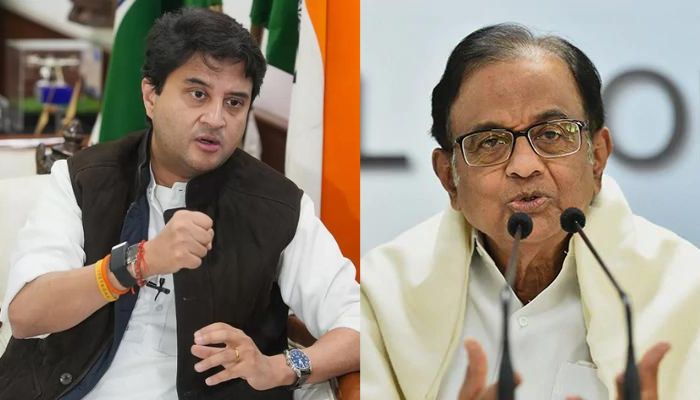Chidambaram Points Out The Claim “74 Airports In 7 Years” Is Hollow And Untrue: UDAN Scheme By BJP Did Not Really Take Off
Chidambaram asserted that BJP’s claim that they built 74 airports in 7 years is hollow and untrue, the UDAN Scheme crash landed.

Chidambaram Points Out The Claim “74 Airports In 7 Years” Is Hollow And Untrue: UDAN Scheme By BJP Did Not Really Take Off.
The Bharatiya Janata Party (BJP)-led National Democratic Alliance (NDA) government’s claims of building 74 new airports since taking office, have come under scrutiny during a contentious exchange of words between senior Congressman P. Chidambaram as well as Union Civil Aviation Minister Jyotiraditya Scindia. Chidambaram charged that the administration had been boasting and misrepresenting its accomplishments. Scindia replied that the Congress party was not good at fact-checking.
When Chidambaram pointed out the government’s false and exaggerated claims, claiming that just 11 new airports had actually been constructed since May 2014, the issue was sparked. The remaining “airports” consisted of two waterdromes and nine helicopter stations, both of which were discovered to be non-operational soon after they were built.
Fifteen out of the 74 airports the administration boasted of building, have already ceased operations since there aren’t enough flights. On top of that, a startling 225 of the 479 additional routes introduced by the BJP-NDA government are currently no longer in service. Chidambaram expressed gratitude to The Hindu for supplying this material and emphasized the party’s resolve to reveal the reality behind the assertions made by the government.
The continuing verbal battle between the Congress as well as the BJP-NDA administration has further highlighted the political environment’s propensity for exaggeration and partial truths. Public reservations of politicians as well as their statements is brought on by both sides’ apparent eagerness to make their cases.
Although the development of new airports as well as the expansion of aviation infrastructure are unquestionably necessary for connectivity and economic growth, it is imperative that the government inform the public with truthful and open information. False assertions and exaggerations only damage the ruling party’s reputation and cast doubt on its dedication to real growth.
Reply by Civil Aviation Minister Jyotiraditya Scindia
The battle of words between the Congress party and the BJP-led NDA government has escalated, with Union Civil Aviation Minister Jyotiraditya Scindia launching a vehement defense of the claims made by senior Congress leader P Chidambaram. Scindia detailed airport developments as well as additional government initiatives, claiming that Prime Minister Modi’s visionary leadership has resulted in the operationalization of 74 airports, a number of which had remained idle for several decades, that represent national liabilities as a result of former UPA governments’ inaction.

In response to Chidambaram’s assertions, Scindia emphasized the government’s enormous capital investment over the last decade, amounting to about INR 75,000 crore. He stressed how this investment had a significant positive social impact, creating job possibilities as well as gratifying the growing desire of all social groups to travel by air.
Scindia boldly proclaimed that the current administration had accomplished in just 9 years what previous administrations had failed to do in 70 years, demonstrating the administration’s dedication to revolutionary progress.
Chidambaram was harshly criticized by the Union Minister, who charged him with being frantic to survive. The Congress party’s desperate attempt to remain relevant, according to Scindia, was clouding its judgment and causing it to repeat half-truths. Scindia questioned Chidambaram’s fact-checking skills.
In response to the issue of routes under the government’s regional connectivity plan (RCS), popularly known as UDAN, that have been cancelled, Scindia stressed that these routes have been reopened for bidding. Airlines participated in fresh rounds of the UDAN scheme to bid on a number of canceled routes as they increased their capacity and the demand for air travel increased.
The Minister went on to defend the closure of some lines, blaming market conditions for its occurrence. He promised that when the demand for air travel rose, the existing airport infrastructure would be used wisely.
Scindia used the occasion to promote the accomplishments of the administration in airport construction. He stated that since 2015, 12 airports have been made operational, including Hirasar, which was just opened and will soon have flights. Surprisingly, there were just three greenfield airports built in the 65 years before to 2015. Further demonstrating the UDAN scheme’s positive impact on boosting air connectivity, the civil aviation minister proudly informed that more than 1.23 crore persons and 2.23 lakh flights had flown under the program.
It is clear that both the Congress and the BJP-NDA administration are anxious to make their points in the ongoing verbal battle. The Congress party is vigilant in examining these claims, highlighting the need for transparency and veracity in the presentation of statistics, even as the administration highlights its accomplishments in airport expansion as well as regional connectivity.

Reality of UDAN Scheme
The BJP government boasted that it had built “74 airports in seven years,” which was more than had been accomplished in the seven decades since Independence. A closer look, however, reveals a different picture because only eleven of these airports were built from the ground up. Surprisingly, fifteen airports are now inactive because less than half of the connections started under the regional connectivity plan (RCS) have been unsuccessful and have collapsed.
The RCS, which was started in 2017 to improve air connectivity for smaller cities and revitalize underutilized airports, was at the center of airport development activities. This included reviving outdated airports that were either underutilized or never used. According to the Ministry of Civil Aviation’s answer, a startling 225 of the 479 lines that were launched to revitalize these airports have already stopped operating.
The UDAAN scheme’s failure might be partly ascribed to its market-driven strategy, which put the burden on the government to make routes more profitable for airline carriers. According to the program, bids are put in based on the airline operator’s evaluation of the demand for a particular route or routes.
A further setback to the scheme’s prospects was caused by the second wave of COVID-19, which struck a devastating blow to the economy in general and the tourism as well as transportation sectors in particular. Despite having been in existence for four years, only forty-seven percent of the routes and thirty-nine percent of the unserved and underserved airports were running by July of the previous year. The total amount of new operating routes increased to 102 and 120 in FY19 and FY20, respectively, but fell to 79 in FY21, showing a lack of a sustainable rebound.
The difficulties facing the aviation sector exacerbate the issues with the UDAAN program. The success of the system has been hampered by low returns and high operating expenses, delays in acquiring commuter operator permits, a lack of suitable aircraft, challenges with aircraft leasing, as well as maintenance issues.
The pandemic’s impact on airline operators’ declining financial condition just makes the situation worse. According to an ICRA report, Indian airlines are predicted to post a substantial net loss of INR 12,700 crore during FY22, with an industry-wide debt of INR 50,000 crore. The report emphasizes the need for finance assistance while cash inflows are still problematic for most airlines.
In spite of a slight improvement in 2020, raising money will continue to be difficult for airlines, according to a forecast by India Ratings. Raising capital becomes even more challenging for most companies due to the COVID-19’s recurrent waves and weaker market shares in comparison to the sector leader.
However, the extensive issues facing the aviation industry are not the only reason the UDAN project failure. The collapse of the plan was a result of protracted regulatory clearances, finance constraints, as well as a lack of land with clear titles. Infrastructure renovations that have been put off, problems with airport readiness, short runways, and a lack of regulatory permissions are all contributing factors to the slow development.
In conclusion, despite the government’s so-called efforts to prove the UDAAN scheme’s success by constructing several airports, the situation is far from ideal. The demise of routes and the underutilization of airports have brought to light the flaws in a market-driven strategy and the difficulties facing the aviation sector. The scheme’s failure makes it clear that a more thorough and long-term approach is required to ensure significant improvement in India’s airport infrastructure and air connectivity.
Therefore, the charge levelled by the Congress party is not without foundation. The government must provide correct information and make sure that its programs are carried out successfully and sustainably if it wants to be regarded as credible as well as trustworthy. Building infrastructure is one thing, but it’s as important to make sure that these facilities continue to function and advance the country.
Instead of indulging in a verbal brawl, it is crucial for the opposition as well as the ruling party to have a constructive discussion based on factual evidence. Citizens should be able to make well-informed choices based on accomplishments rather than exaggerated rhetoric because elected officials owe them honest and open communication.
The protracted conflict emphasizes the need for good government and accountability. While the administration may highlight some achievements, it is equally important for the opposition to examine and challenge these claims in order to give the public a true picture of the nation’s development.
The onus is on the BJP-NDA administration as well as the Congress party to put the needs of the country before gaining political advantage while the verbal battle rages on. Together, they can create an environment where productive arguments result in more significant accomplishments for the Indian people by working toward a common goal of growth.






